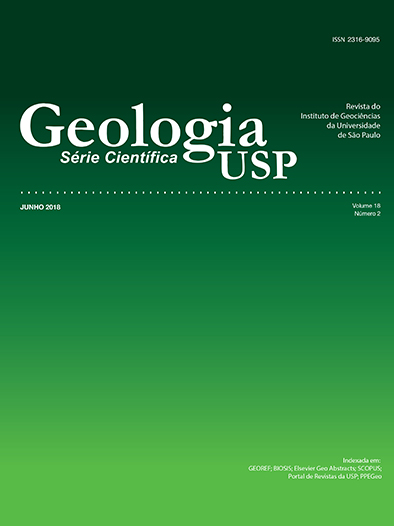Basic intrusive rocks in southeastern Dom Feliciano Belt, Rio Grande do Sul: petrography and geochemistry of associations I and II
DOI:
https://doi.org/10.11606/issn.2316-9095.v18-125442Keywords:
Diorite, Passo da Fabiana Gabbros, Basic magmatism, Layered Intrusions.Abstract
Dioritic, gabbroic and other mafic-ultramafic intrusions record both magma extraction and transport processes from the mantle, resulting in vertical material accretion to the crust, as well as the interaction between these two reservoirs. Recently, these rocks are pointed also as important petrogenetic markers, when associated with intermediate to acid magmatism, in orogenic to post-collisional settings. In the southeastern portion of Dom Feliciano Belt (CDF), Rio Grande do Sul, which is composed mainly by granitoids, minor dioritic and gabbroic predominantly basic intrusions occur, in the region between Pinheiro Machado and Pedro Osório. This article presents geological, mineralogical, petrographic and geochemical characterization of these rocks, proposing thus the separation of two main associations. “Association I” (AI), composed by commonly cumulate gabbroic rocks, sometimes in layered intrusions, comprises the bodies Passo da Fabiana, Passo da Olaria, Arroio Santa Fé and Desvio Herval. “Association II” (AII), dioritic to gabbroic, comprises massive to locally foliated rocks, in the occurrences of Alto Alegre, Passo dos Machados and Campo Bonito. Both associations are subalkaline, with medium-K (AI) and medium to high-K (AII) calc-alkaline affinity, showing high-alumina contents (Al2O3 > 17%), even for the non-cumulative terms. Differences regarding major elements (CaO, Mg# and alkalis), as well as minor and traces (P2O5, Zr, Nb, Y, total and REE patterns) support the proposed division. The magnetic signatures suggest control on the emplacement of intrusions by lithospheric discontinuities, which would have enabled the ascent and emplacement of these magmas to upper crustal levels. Petrogenetic processes involving the participation of mantle-derived melts in supracrustal reservoirs, and their evolution in deep crustal hot zones are proposed.
Downloads
Downloads
Published
Issue
Section
License
Authors who publish in this journal shall comply with the following terms:
- Authors keep their copyright and grant to Geologia USP: Série Científica the right of first publication, with the paper under the Creative Commons BY-NC-SA license (summary of the license: https://creativecommons.org/licenses/by-nc-sa/4.0 | full text of the license: https://creativecommons.org/licenses/by-nc-sa/4.0/legalcode) that allows the non-commercial sharing of the paper and granting the proper copyrights of the first publication in this journal.
- Authors are authorized to take additional contracts separately, for non-exclusive distribution of the version of the paper published in this journal (publish in institutional repository or as a book chapter), granting the proper copyrights of first publication in this journal.
- Authors are allowed and encouraged to publish and distribute their paper online (in institutional repositories or their personal page) at any point before or during the editorial process, since this can generate productive changes as well as increase the impact and citation of the published paper (See The effect of Open Access and downloads on citation impact).





